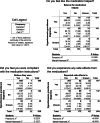Assessment of management approaches for hyperemesis gravidarum and nausea and vomiting of pregnancy: a retrospective questionnaire analysis
- PMID: 35915406
- PMCID: PMC9341047
- DOI: 10.1186/s12884-022-04922-6
Assessment of management approaches for hyperemesis gravidarum and nausea and vomiting of pregnancy: a retrospective questionnaire analysis
Abstract
Background: Hyperemesis gravidarum is the most severe form of nausea and vomiting of pregnancy, or morning sickness. 2% of pregnancies in the United States are affected by hyperemesis gravidarum. The condition is characterized by severe vomiting in pregnant people, especially during the first trimester, often leading to hypovolemia and weight loss. The standard of care for hyperemesis and nausea and vomiting of pregnancy is commonly ineffective. We hypothesize that based on patient experience; the current treatment guidelines for hyperemesis are not clinically effective. Our objective was to identify the efficacy of the various management approaches that are currently in place for hyperemesis and nausea and vomiting of pregnancy.
Methods: A questionnaire was designed based on diagnostic criteria, standard demographic identifiers, and common medications for the treatment of hyperemesis gravidarum. This questionnaire was distributed online to through hyperemesis and nausea and vomiting of pregnancy support groups, personal social media, and institutional email.
Results: In our study, most participants diagnosed with hyperemesis gravidarum trialed at least three medications, most of which were ineffective and/or had severe side effects. The most used medication for treatment of hyperemesis gravidarum is ondansetron, a standard antiemetic, with fatigue and constipation being the most reported side effects. All data in the dataset was coded as categorical and analyzed using contingency tables using Mantel-Haenszel Chi square tests.
Conclusions: The data presented in this research provides insight into the suffering that patients with these diagnoses face day-to-day due to the lack of efficacious, well-tolerated treatment options. Establishing this gap in treatment can facilitate the development of effective treatments that will provide relief for thousands of patients.
Keywords: Hyperemesis Gravidarum; Morning sickness; Nausea; Nausea and vomiting of pregnancy; Pregnancy; Quality of life; Vomiting.
© 2022. The Author(s).
Conflict of interest statement
The authors declare they have no competing interests.
Figures




Similar articles
-
[Expert consensus from the College of French Gynecologists and Obstetricians: Management of nausea and vomiting of pregnancy and hyperemesis gravidarum].Gynecol Obstet Fertil Senol. 2022 Nov;50(11):700-711. doi: 10.1016/j.gofs.2022.09.002. Epub 2022 Sep 21. Gynecol Obstet Fertil Senol. 2022. PMID: 36150647 French.
-
Effect of gabapentin on hyperemesis gravidarum: a double-blind, randomized controlled trial.Am J Obstet Gynecol MFM. 2021 Jan;3(1):100273. doi: 10.1016/j.ajogmf.2020.100273. Epub 2020 Oct 29. Am J Obstet Gynecol MFM. 2021. PMID: 33451591 Clinical Trial.
-
Review article: Management of hyperemesis gravidarum and nausea and vomiting in pregnancy.Emerg Med Australas. 2022 Feb;34(1):9-15. doi: 10.1111/1742-6723.13909. Epub 2021 Dec 6. Emerg Med Australas. 2022. PMID: 34872159 Review.
-
Pregnant women report being denied medications to treat severe nausea and vomiting of pregnancy or hyperemesis gravidarum - findings from an Australian online survey.Aust N Z J Obstet Gynaecol. 2021 Aug;61(4):616-620. doi: 10.1111/ajo.13359. Epub 2021 May 13. Aust N Z J Obstet Gynaecol. 2021. PMID: 33984156
-
Hyperemesis gravidarum--assessment and management.Aust Fam Physician. 2007 Sep;36(9):698-701. Aust Fam Physician. 2007. PMID: 17885701 Review.
Cited by
-
GDF15 Targeting for Treatment of Hyperemesis Gravidarum.Medicines (Basel). 2024 Aug 30;11(7):17. doi: 10.3390/medicines11070017. Medicines (Basel). 2024. PMID: 39311313 Free PMC article.
-
Comparison of two proxies for the preconception weight using data from a pre-pregnancy cohort in Benin: Weight measured in the first trimester of pregnancy vs estimated by Thomas' formula.PLoS One. 2024 Nov 4;19(11):e0312840. doi: 10.1371/journal.pone.0312840. eCollection 2024. PLoS One. 2024. PMID: 39495747 Free PMC article.
-
Assessing the approaches to nausea and vomiting in pregnancy: insights from a nationwide survey of Italian gynecologists (PURITY light).Front Med (Lausanne). 2025 Jan 27;12:1462860. doi: 10.3389/fmed.2025.1462860. eCollection 2025. Front Med (Lausanne). 2025. PMID: 39931555 Free PMC article.
References
-
- Einarson TR, Piwko C, Koren G. Quantifying the global rates of nausea and vomiting of pregnancy: a meta analysis. J Popul Ther Clin Pharmacol. 2013;20(2):e171–e183. - PubMed
-
- Jansen LAW, Koot M, Hooft J, Dean C, Bossuyt PMM, Ganzevoort W, et al. Grooten, Iris. The Windsor Definition for Hyperemesis Gravidarum: a multistakeholder International Consensus Definition. Eur J Obstet Gynecol Reprod Biol. 2021:266. 10.1016/j.ejogrb.2021.09.004. - PubMed
MeSH terms
Substances
LinkOut - more resources
Full Text Sources
Miscellaneous

